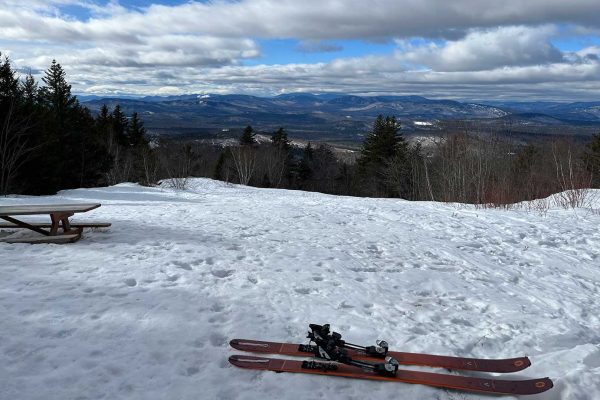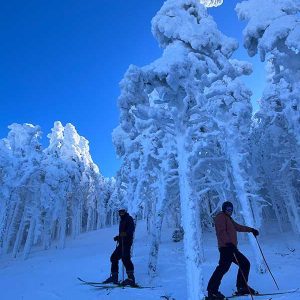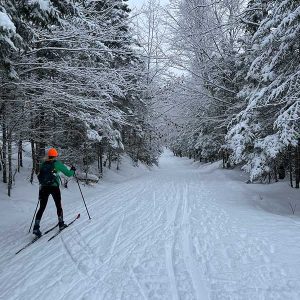My adventures in the winter revolve around snow. Whether slapping on a headlamp for some ski laps after work, chomping at the bit for a weekend expedition to the mountains, or bursting out the door at the sight of a flurry for some snowflake snacks, snow gets my blood flowing and spirits high like nothing else. I’ve had my fair share of snowy fun this winter, but it has required some extra work due to high temperatures and infrequent snowfall.

Resting atop the Mt. Abram snow fields after a ski trek up the mountain
A January trip just across the border to the cross-country ski mecca of Jackson, New Hampshire, with my partner Hannah was indicative of this unwelcome trend. Rain spattered the windshield throughout our drive past an ice-free Sebago Lake and onward to the foothills of the White Mountains. We stayed true to course through the deluge if only to entertain the naively optimistic hope that rain may turn to snow on our timeline.
Upon our arrival, with a heavy flake or two making an occasional appearance amid the drops, an apologetic employee told us that we might have better luck if we braved the slick Carter Notch Road up to Prospect Farm to take advantage of the slight elevation increase. Dubiously, we inched our way past Eagle Mountain, and sure enough, rain gave way to pillowy powder that had evidently been coming down for hours. A couple hundred feet into the clouds just barely gave us the edge we needed to have a spectacular day gliding across fresh snow.
Snow is beautiful. The way it coats a still landscape with serene uniformity, the levity and brightness it brings to outings on short winter days, the patterns of the wind made manifest in physical form. Snow is also useful. Stores of crystalline water prepared to be unleashed in life-bringing surges by the spring sun; refuge for small creatures scurrying through the matrix of the subnivean zone; insulation for forest floors that would otherwise succumb to the cold each winter. Not to mention, it is the perfect medium for sledding, skiing, designing, building, jumping, flopping, throwing, and resting.

Appreciating the windswept snow on Saddleback Mountain.
It is not hyperbole to say that snow is absolutely essential for life in Maine—culturally, ecologically, recreationally, economically, and historically. Maine’s 18 alpine ski mountains and related activities contribute more than $1 billion and 5,000 jobs to the state’s economy each year, while our 14,000 miles of snowmobiling trails bring in some $606 million annually. Premier cross-country skiing facilities in Fort Kent and Caribou have served as training and racing grounds for Olympic athletes. Camden hosted its 33rd annual US National Toboggan Championships this winter. Maine’s flora and fauna rest and regenerate beneath a white comforter that has arrived dependably each year for millennia. People have hewn their lives from the snow for more than 13,000 years along the banks of Maine’s mighty rivers, jagged coastlines, and weathered topography.
I am fortunate enough to have grown up in Maine, pampered by changing seasons and abundant natural beauty. Flakes have always sent me scampering to the window, a rising anticipation unrivaled by sun, wind, or rain. A snowstorm molds the landscape unlike any other weather event, softening hard edges and blanketing barren land that can then be traversed in new and exhilarating ways. For me, that generally looks like sledding, glissading, and romping, and alpine, Nordic, and backcountry skiing. Lately, those activities have been happening farther away from home with more space between.
Our upcoming March weekend navigating the Maine Huts and Trails network is approaching with plenty of crossed fingers. An 11-mile span between huts is more appealing on skis than on foot. My parents recently made the most of a February getaway to the Hidden Valley Nature Center, a gorgeous location regardless of conditions, but the sled my dad designed when I was young to haul gear and weary children across snow behind skis instead bumped its way along icy grass trailing spike-adorned boots.

Finding fresh flakes with Hannah in Jackson, NH
I cannot imagine a life without snow. I don’t want to. And yet each week this winter, my imagination is put to the test. Flurries turn to showers, drifts to puddles, and ski outings to hikes. 2023 was the warmest year on record, by a lot. We’re seeing that change more drastically here in Maine, particularly during our winters, which are warming faster than any other season. Maine’s winters are now a full two weeks shorter than they were a century ago, and that trend is continuing.
Snow is one of the many reasons I work in climate advocacy for the Natural Resources Council of Maine. Advocating for a trails bond that will put $30 million toward the construction and maintenance of trails will help snowmobile clubs, cross-country ski outfits, and local trail groups get back on their feet after a devastating winter. Advancing clean energy solutions like solar and offshore wind will deliver a clean energy future defined by sustainable generation. Reducing our dependence on dirty fossil fuels by electrifying transportation and buildings, reforming our electric grid, rethinking our development and transportation models, and holding polluters accountable will slow climate change and stabilize our environment. Continuing to build on a strong Climate Action Plan will make Maine more resilient to the changes we are already seeing while avoiding more drastic changes in the future.
There is work to be done to forge a safe and vibrant future for Maine, and throughout it all, I will be in search of snow.
—Josh Caldwell, NRCM Climate & Clean Energy Outreach Coordinator











Nice piece Josh! Thanks for sticking up for the snow. It really is the lifeblood of Maine’s winter economy and is fading fast in ski country. Would that be our beloved Mount Abram in the top photo?
It is indeed! A wonderful sunny day, some dicey bits on the way down, but always a worthwhile hike up!
This winter I had to be more creative than in the past too, and had to accept icy one last xc ski laps near Caribou Bog when I visited Orono, which usually has some snow in February!
Excellent article, Josh. Your passion for snow and those industries impacted is well stated.
I’m glad to have grown up in New England, not far from your dad, where in my youth snowdrifts were taller than me and snow piles lasted well into the Spring.
The times are a changing and I cherish those memories.
Keep up the good work.